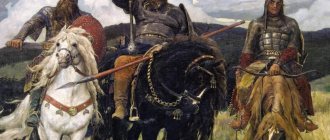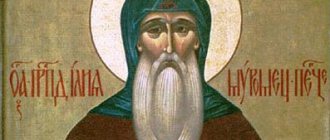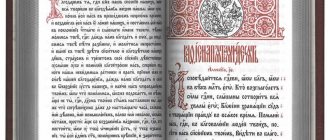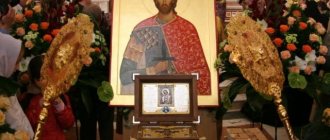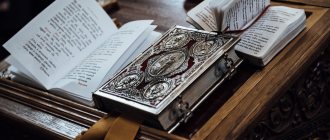Article on the topic
Ilya Glazunov: “Why do we distort the truth even in our own textbooks?”
“Some researchers are still skeptical about the reality of Ilya Muromets - his biography seems too fabulous to scientists,” says Sergei Khvedchenya, Doctor of Geographical Sciences, researcher at the Institute of History of Ukraine of the National Academy of Sciences of Ukraine (Kyiv).
However, the materials collected by the researcher made it possible not only to completely restore the biography of the Holy Russian hero, but also to answer controversial questions about the life of Ilya Muromets, which perplexed many researchers.
History of creation
Every year on January 1, Orthodoxy commemorates the memory of St. Elijah. The man met old age in the Pechersk Lavra and died at the hands of the cruel Polovtsians. Studies of the remains of the martyr confirm the opinion that the hero Ilya Muromets is not a fictional character, but a real person.
Ilya Pechersky - the alleged prototype of Ilya Muromets
An analysis of the relics, which scientists carried out in 1988, indicates specific features: the deceased man suffered from a rare disease that affects the ability to move. Traces of wounds were found on the bones and tissues of the saint. The listed facts give reason to assert that Elijah Pechersky (the man is buried under this name) is a prototype of a mighty hero.
Perhaps the exaggerations that are characteristic of tales and legends are the consequences of constant retelling. Or the creators of the epics added metaphors to the story to impress the listeners.
Relics of Elijah of Pechersk
Muromets was indeed different from his contemporaries. The description of the hero (confirmed by scientists) proves that the warrior’s height was 177 cm. The average height of men in Ancient Rus' did not exceed 160 cm. It is necessary to mention quotes from Boris Mikhailichenko, a researcher of the relics:
“...on the bones of the mummy the so-called tuberosities are very well developed. And we know that the better a person’s muscles are developed during life, the more these tubercles he will have. That is, he had a developed muscular system.”
“In addition, an X-ray examination of the skull revealed changes in the part of the brain called the sella turcica.” At all times there are people with such symptoms, they say about them - “oblique fathoms in the shoulders.”
The first written mention of Ilya Muromets dates back to 1574. The Lithuanian governor, in a note to Ostafy Volovich, casually mentions the brave warrior “Ilii Murawlenina” and the imprisonment of the Russian hero in the dungeon of the Kyiv prince.
There is a theory that handwritten evidence of the exploits of Muromets was deliberately destroyed. The hero's supposedly humble origins cast a shadow on the boyar warriors and their descendants.
Elijah's departure to the monastery
If Ilya’s military exploits were widely reflected in epics, little is known about the monastic period of his life. The hero was most likely forced to go to the monastery by injury. The holy relics of St. Elijah testify to severe injuries - a fracture of the right collarbone and two right ribs after being struck by a combat club. Scientists have established that the hero-monk died in battle! At the end of the 12th century. Attacks on Kyiv became more frequent, and the monks had to defend their monastery. The Svyatorussky hero died from a wound to the area of the projection of the heart, penetrating into the chest cavity. Death, apparently, occurred instantly.
Biography
There are fierce debates about where Ilya Muromets is from. The initial theory says that the hero was born in the village of Karacharovo, which is located near the city of Murom, Vladimir region.
Ilya Muromets on horseback
Researchers of the hero’s biography adhere to the explanation that the strongman’s homeland is the village of Karachev, located near Moroviysk, Chernigov region. The supposed places of birth of the hero are consonant, so the error easily crept into the epic.
It is not yet possible to obtain reliable information about the man’s origins. The possibility that Ilya Muromets is Ukrainian cannot be ruled out. By the way, the patronymic of the famous hero is Ivanovich:
“And in the glorious Russian kingdom, And in that village of Karacharovo, To honest, glorious parents, to a mother, Ilya Ivanovich’s son was born here, And by nickname was the glorious Muromets.”
The baby, who was born into a peasant family, suffered from an unknown disease since childhood. The child had no feeling in his lower limbs and could not move independently. It was rumored in the family that the cause of the disease was a curse. Elijah’s grandfather did not want to accept Christianity and cut up the Orthodox icon. The descendant of a pagan paid for disrespect for the saints.
Ilya Muromets on the stove
A detailed biography of the hero can be traced from the hero’s 33rd birthday. Ilya, suffering from his own weakness, lay on the stove. Suddenly there was a knock on the door. “Wandering Kaliki” (aka folk healers) helped the future warrior get back on his feet. For the miraculous salvation, Ilya gave his word that he would protect the Russian land from enemies and atone for his grandfather’s sin.
Having received the long-awaited freedom, the man left his native village and set off to perform feats. On the way to Kyiv, Ilya encountered his first serious opponent. The Nightingale the Robber terrorized the area, not allowing travelers to cross the Bryn Forest.
Ilya Muromets and the Nightingale the Robber
The fight ended quickly, and the man delivered the troublemaker to the chambers of Prince Vladimir. The Lord of Rus' was impressed by the man’s feat, but the peasant attire displeased the reigning lady. Instead of the reward promised for the robber, the king threw a worn fur coat at Ilya’s feet. The brave man could not bear the insult. Muromets was locked up for his impudent behavior.
Perhaps this would have been the end of the man’s exploits, but the Polovtsians attacked Rus'. Having shown military talents, physical strength and peasant ingenuity on the battlefield, Muromets earned a place in the tsar's squad.
Weapons of Ilya Muromets - mace and treasure sword
For just over 10 years, the hero restored order in the territory of ancient Rus'. The man accomplished many feats about which legends and songs were written. Ilya’s favorite weapons are a heavy mace and a treasure sword, which was given to the man by the hero Svyatogor.
There is a change of power, and a new ruler ascends to the throne. Prince Igor, about whom “The Lay of Igor’s Campaign” narrates, leads his squad into battle with an old enemy. But there are too many nomads, Ilya Muromets is seriously wounded. And here theories about the fate of the hero diverge again:
“... from these Tatars and from the filthy ones, his horse and heroic horse became petrified, and the relics and saints and old Cossack Ilya Muromets became.”
In other words, the hero died during the battle. Another epic claims that a faithful horse carries its owner from the battlefield. The man regains consciousness at the walls of the monastery and remembers his promise to atone for his grandfather’s sin. Ilya throws away his ammunition and takes monastic vows. The man spends the remaining years in the Kiev-Pechersk Monastery, making a promise not to take up arms.
Image of Ilya Muromets near the stone
The Tale of Bygone Years mentions the internecine war between Rurik Rostislavovich and Roman Mstislavovich. In addition to the Russian princes, Polovtsian mercenaries took part in the battle. The robbers reached the monastery and killed the clergy. Ilya, faithful to his vow, did not take up arms and died from a spear in the heart.
Fight with the Nightingale the Robber
The most famous feat of Ilya Muromets is the battle with Nightingale the Robber, who captured the direct road to Kyiv and did not allow anyone passage - “neither on horseback nor on foot.” The liberation of the path to Kyiv by the epic hero (1168) is confirmed by historical facts. During Ilya’s arrival in Kyiv, the throne was occupied by Prince Mstislav, who set the task of organizing the protection of trade caravans, which were mercilessly plundered by the Polovtsians. Most likely, the prince entrusted this to Ilya Muromets, who was a member of the princely squad.
Nightingale, it seems, was a robber who traded in thefts on the road, and he was nicknamed Nightingale for his ability to whistle well. Ilya Muromets, having defeated the whistler, cleared the straight road, which was of great economic importance. If the direct road is five hundred miles, then the roundabout path is “as much as a thousand.” Clearing the straight path from robbers was equated by the people with a feat.
Film adaptations
Ilya Muromets stopping by a stone is an image familiar from childhood. It is not surprising that many films and cartoons have been made about the hero, and many paintings have been written.
Boris Andreev was the first to try on the role of a powerful warrior. The film “Ilya Muromets” was released in 1956. The plot is based on classic epics about the hero and scenes from Pushkin’s fairy tales.
Boris Andreev as Ilya Muromets
The Soviet cartoon about a warrior was released in 1975. The second part was released three years later. Animated films tell about significant events in the life of a warrior. The musical setting is compositions from the opera “Ilya Muromets”.
Ilya Muromets in the Soviet cartoon
In 2007, the animation film studio "Melnitsa" released the cartoon "Ilya Muromets and Nightingale the Robber." The image of a taciturn strongman, beloved by kids and their parents (the one who voiced the hero did not have to memorize much text), will later appear in four more cartoons dedicated to Russian heroes. The voice of Muromets was Valery Solovyov and Dmitry Bykovsky-Romashov.
Ilya Muromets in the Russian cartoon
In the film “Real Fairy Tale” (2010), the epic character was transferred to modern reality. Ilya holds the position of guard for Koshchei the Immortal and does not at all look like a true hero.
Alexey Dmitriev as Ilya Muromets in the film “Real Fairy Tale”
In addition to films, the image of a strong and courageous man is reflected in paintings, musical compositions, performances and computer games.
Quotes
“I am going to serve for the Christian faith, and for the Russian land, and for the capital city of Kyiv...”
“I am from the city of Murom, Ilya, son Ivanovich. And I came here along the direct road past the city of Chernigov, past the Smorodina River.”
“My father of light had a voracious cow. I also ate a lot. Yes, by the end her belly was cracked.”
“Run, you damned ones, to your places, and create such glory everywhere: Rus' the land does not stand empty.”
“Forgive me, mother, I am not a worker in the field, not a breadwinner. Tsar Kalin prepared a mortal arrow in the heart of Kyiv. It’s not a great honor for me, good fellow, to sit in Karacharovo.”
Trinity Church
Trinity Church rises on the hill. It was built in 1828. Now it is in a ruined state, but restoration is underway. So maybe in a few years it will be revived. It offers beautiful views of the Oka River and the Trans-Oka region.
Trinity Church in Karacharovo
Trinity Church in Karacharovo
Trinity Church in Karacharovo
View of the source of Ilya Muromets
Oka in Karacharovo
© Website “On the Roads of the Middle Way”, 2009-2021. Copying and reprinting of any materials and photographs from the site anashina.com in electronic publications and printed publications is prohibited.
